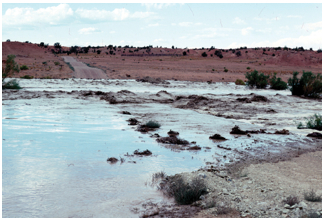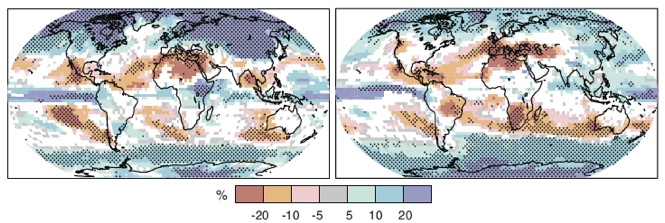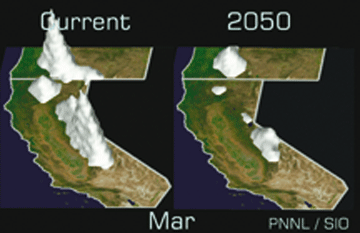Future Geographies: Global Precipitation Patterns
Changes in the the global distribution of precipitation will result from increased atmospheric water vapor originating from warmer oceans, especially in the tropics. Rising temperatures will increase evaporation and drive the hydrologic cycle at a more vigorous pace. Not only will the amount of precipitation change, so will the kind and timing. More precipitation now falls as rain than snow in northern regions. The average rainfall in parts of northern Europe has increased by 50%. Between 1900 and 2005, significantly more precipitation has fallen in the eastern parts of North and South America, and northern and central Asia than normal. Total snow cover has on average decreased in both hemispheres.
 Figure 7.43 Flash flood on Twenty-five Mile Wash on Hole-in- the-Rock Road. Maximum water depth is approximately 8 feet. The rain which caused this flood fell 68 miles west. (Courtesy USGS)
Figure 7.43 Flash flood on Twenty-five Mile Wash on Hole-in- the-Rock Road. Maximum water depth is approximately 8 feet. The rain which caused this flood fell 68 miles west. (Courtesy USGS)
Precipitation variability causing droughts and floods alike will be widespread due to global warming. Some regions like the Sahel, the Mediterranean, southern African and parts of southern Asia have already experienced decreased precipitation. Though they experience little annual precipitation overall, many dry places receive much of their rainfall in a few brief, but intense storms. Intense precipitation events accompanied by flash flooding are predicted to be more frequent even in regions where annual precipitation is forecast to decrease. Longer dry spells between intense precipitation events are also expected.
Current models suggest that precipitation is likely to increase in some tropical wet regions of the continents, and the tropical Pacific Ocean. Drier conditions are expected in the subtropics while high latitudes will experience an increase in precipitation. Upper midlatitude and high latitude increases in precipitation is due to the displacement of the jet stream to a more northerly track.

Figure 7.44 Relative Changes in precipitation for period 2090-2099 relative to 1980 - 1999. December to February on left, June to August on right. (Courtesy IPCC)
 Figure 7.45 Computerized projections of western United States snowfall levels in 2050 compared to present day. (Source: Scripps )
Figure 7.45 Computerized projections of western United States snowfall levels in 2050 compared to present day. (Source: Scripps )
The likelihood that precipitation falls as rain than snow increases as air temperatures increase. This is especially true during the fall and spring and in places where temperatures hover near freezing. Changes in the type of precipitation has been observed in many places, but especially in the middle and high latitudes of the Northern Hemisphere. Increased rain has meant reduced snowpacks and difficulty managing reduced water supplies through the dry summer months. California for example, depends on snowpack in the Sierra Mountains for water supply during the summer. But changes in the precipitation will require new infrastructure and changes in how water resources are governed. Water managers will have to balance the need to fill reservoirs for water supply or maintain reservoir space to winter flood control.
 Figure 7.45 View of monsoon rain in Kerela (Source: Wikimedia )
Figure 7.45 View of monsoon rain in Kerela (Source: Wikimedia )
Precipitation associated with the monsoons is predicted to change into the next century as a result of global warming. Models predict increased precipitation and interannual precipitation variability for the Asian monsoon southern part of the west African Monsoon. A decrease in precipitation is expected in the Sahel in the northern summer. Precipitation is expected to increase in the Australian monsoon. Monsoon precipitation in Mexico and Central America is is expected to decrease due to increasing precipitation over the eastern equatorial Pacific from Walker Circulation and local Hadley Cell circulation changes.
Assess your basic understanding of the preceeding material by "Looking Back: Patterns of Precipitation and Future Geographies" or skip and continue reading.
